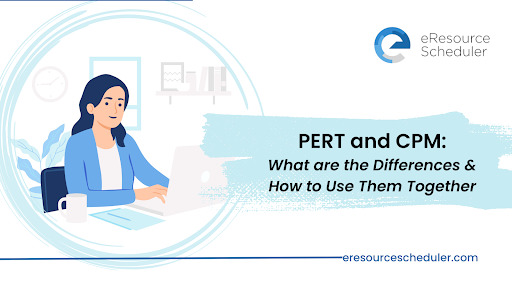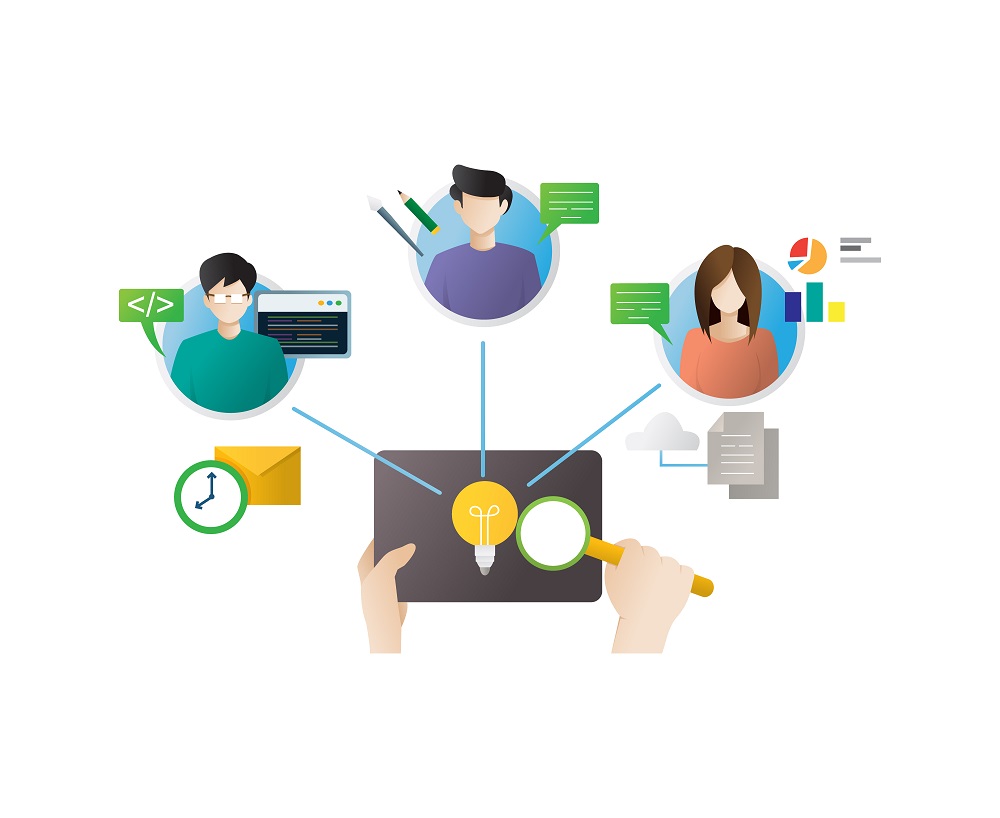
Are you a project manager just getting started in the industry or an experienced one with several large-scale projects under your belt? Whatever the case, it's best to keep yourself abreast of the latest project management tools to keep your project planning and execution skills sharp.
In this blog, we discuss two project management techniques, PERT and CPM, that will increase your project's efficiency and planning. We dive into what these tools mean, how to use them and why you should use both together.

PERT, or Project Evaluations Review Technique, in project management, is a work planning process through which managers can identify how long it takes to complete a task. It is a statistical tool that visually charts out all required tasks that must be completed within a specific project. Through PERT, you can also identify the minimum time necessary to complete a task.
PERT was developed by the US Navy in 1958 to manage their special submarine missile program. However, the tool is frequently used by project management teams to simplify and reduce the risk associated with projects.

Managers need tools to help them manage a project and PERT is one of those tools. Other benefits of using PERT are:
Maximises resource utilization.
Reduces project risks because managers account for all necessary activities for project completion.
Allows managers to estimate a project end date by taking into account the overall task count.
Highlights interdependencies between resources.
Ensure accountability as every member will be able to see what is assigned to them and others.
But, probably, the best part of PERT is that managers can use it even if they have minimal project schedule data. Lastly, PERT is a great decision making tool for managers as it helps them evaluate where and which resources are needed for current and future projects.
The focus of PERT methodology is on time — if time is controlled, project costs will be minimised as well.
To use PERT you need to:
List all the activities
Identify project milestones
Determine activity sequence
Draw a chart/network where activities are arrows and milestones are circles
Estimate activity duration
PERT methodology uses three points to calculate a weighted time average for events in a project:
Optimistic (O) - the “best-case” scenario or the shortest time required for a task. This has no risks.
Most Likely (M) - account for some risks and delays in calculating time.
Pessimistic (P) - This is the “worst-case” estimate and therefore projects the longest duration to complete the work.

Critical Path Mode (CPM) is a step-by-step project management technique that helps identify the longest sequence of activities that must be completed for a project to be considered “done.” A manager can identify the domino effect that will occur if one task gets delayed by using CPM.
CPM, like PERT, was developed in the late 1950s, as a technique to reduce scheduling inefficiencies and lower project costs. CPM gained popularity in the project management field because it allows teams to break down large projects into bite-sized, actionable steps.
Some reasons why you should consider using CPM technique include:
CPM minimises the number of bottlenecks in a project, improves planned progress and reduces the hours spent on non critical tasks.
The diagram highlights interdependencies in the work scope, so managers can prioritise tasks with a concise network diagram. This process also helps identify which activities cannot be completed side-by-side.
The tool allows managers to compare time allotted to activities versus actual time taken.
CPM also provides a clear communication process between all stakeholders.
To be able to take advantage of CPM, you need to know how to perform it. Use our step-by-step guide on calculating CPM for your next project.
List all specific activities related to the whole project.
Identify the interdependencies amongst tasks. What tasks have an immediate predecessor? This will help to generate an activity sequence — what tasks have to be completed first and which can run simultaneously.
Draw out a network diagram with arrows that visualises the progress amongst tasks.
Calculate the time required for each task. You can refer to previous project data, industry standards, or even your own experience to estimate time.
Use the forward pass and backward pass methodologies to calculate the earliest start (ES) time, task durations and the latest completion time (LC).
Highlight the critical path with a clear network diagram. The critical path is the longest time between when the first task starts to the completion of the last task.
Calculate float. Float or slack refers to the amount of flexibility you have within a project. These tasks can get delayed without impacting the final project delivery irrespective of the predecessor task.

While both PERT and CPM are techniques that can lead to effective scheduling and project management, they aren't the same. We've highlighted the differences between the tool metrics in the following table.
| PERT | CPM | |
|---|---|---|
| Type of Tool | Visual Tool | Statistical Tool |
| What it Controls | Controls time management | Controls costs and time |
| Best Use Scenario | Ideal for research and product development projects Used with tasks are non-repetitive | Ideal for construction or manufacturing processes Used with tasks are repetitive |
| Methodology | Uses a three-point methodology to estimate time PERT is calculated based on weighted time for events | Uses one single methodology to estimate time and cost CPM is focused on activities and highlights interdepencies |

What should you use? PERT or CPM? The reality is that PERT and CPM are complementary tools. If you want the best results and most accurate planning for your project, you should know how to use them together.
Here's an example of how you can use both together. Suppose you have to construct your home. Using PERT, outline the overall project path or project plan and dodge unexpected delays. Now, if you need the house sooner than expected, use the CPM technique to identify the critical path and reduce the overall time required for the project. In this case, you might realise that the civil work is part of the critical path and is possibly taking the most time to complete. With this knowledge, you can reduce the time required for civil work by speaking to the contractors or increasing manpower.
Believe it or not, in the dynamic project management landscape, CPM and PERT are a few methodologies that have left a profound mark on organizations. Developed in the mid-20th century, these project management strategies have reformed the way projects are executed, and plans are monitored. How? Well, here's how they can do wonders with project management software.

With the critical path method, project managers can handle numerous tasks and interdependencies without any setbacks. Project managers can leverage critical path analysis to break down How PERT and CPM Revolutionized Project Management in the complexities of the entire project into manageable components.
With the critical path method, project managers can identify the critical path and key milestones and map out sequences of activities by highlighting components of the project timeline and resource constraints.
In a nutshell, CRM and PERT can facilitate efficient resource allocation with a work breakdown structure so they can prioritize critical tasks, allocate resources and manpower where they are most needed, track project progress, and optimize productivity to minimize bottlenecks.

Along with providing a work breakdown structure for critical tasks, a critical path analysis chart can also help to handle changes and adapt seamlessly,
In the corporate landscape, uncertainty is inevitable and project managers might encounter unforeseen challenges or delays. With the critical path method, project managers can have a valuable tool for risk management and contingency planning.
Tracing down critical path activities can be challenging. However, CPM and PERT allow project management to analyze "what-if" scenarios, and evaluate the impact of different risk mitigation strategies on dependant tasks.
By simulating different scenarios and critical path programs, every project management body can develop a robust backup plan to address potential disruptions proactively. It can minimize the impact of risks on the project completion date and enhance the organization's ability to adapt to changing circumstances.

Effective project management requires contributions to monitoring and tracking project activities and actual progress against predefined milestones and objectives. A critical path schedule enables project evaluation, so project managers can get valuable insights into process planning, resource usage, project schedule, and critical paths necessary to complete complex projects

A critical path diagram can help team members, stakeholders, and clients to foster alignment and transparency. With a clear critical path algorithm, organizations can gain a clear understanding of the respective roles and responsibilities of project resources.
From analyzing all the tasks to prioritizing them according to the earliest possible completion date, having a CPM and PERT process can help everyone involved in the project get a clear idea of critical milestones.
Using templates or Excel to perform CPM and PERT analysis can be time-consuming and cumbersome. Work planning and resource planning tools can make this step faster. eRS is an end-to-end resource planning software that will aid you in project planning and execution. From highlighting and prioritizing important tasks to calculating the estimated time frames and outlining a final figure in terms of the financials, the software can simplify the path to desired outcome and help organizations to complete scheduled activities without the need of more resources or additional hands on deck.
eRS can help you identify the right resources, build capacity plans, and identify the best and most cost-effective process for global projects. Our software is used by over 500 customers and we would love to be your trusted resource planning partner. To stay ahead of the pack, start our no-commitment, free 14-day trial today.
Also read:
5 best practices for client management
Why you should know mintzberg's 10 managerial roles
Alternatives to monday.Com for team and project management
What is requirement traceability matrix and why you should use it in project management
The significance of resource management: understanding its impact and relevance
Plan Smarter. Schedule Faster.
Join thousands already using eResource Scheduler to align teams, time, and tasks seamlessly.